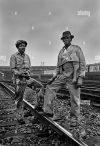Hi Everyone
I'm an employee at Network Rail doing some research for a project for Railway 200.
I'm a complete newbie when it comes to trains/rail so I thought I'd post this here, given the brain trust that exists here!
We found this amazing archive photo from the very talented Barry Lewis showing two rail linesmen in Clapham (date given is 10th May 1976). We'd love to know if anyone has any thoughts or actual experience with the vests/garments worn in the photo. Are these early iterations of PPE?
Our project aims to look at the beginning of PPE, it's evolution from the past up to the present. We've got a ton of questions!
- Were these regulation/standard issue vests during that period?
- Who manufactured them?
- We're these vests considered safe for use?
- Were helmets, gloves, goggles, boots not required at the time - and if not, when were they introduced?
In anyone has any information about these topics, it would be great to hear from you! Any input is most welcome and I thank you in advance!
Cheers
Network Grail.
One of the things you might want to have a look at are copies of the in house BR Film Unit (British Transport Films - BTF) films a good number of which were staff instructional films
including those aimed at track work and track safety. As the film unit started in 1948 that means you can find high quality moving film footage from that date onwards easily enough. Which may help with your project.
Many BTF film unit staff progressed on to being major motion picture film makers - suffice to say you are not talking about 'home movie' type film making.
The BTF film archive is now held by the British Film Institute (BFI) - many films have ended up uploaded onto you tube but the BFI have made selected films available on a DVD collection published in recent years as well as some via there own free to view access at BFI online
I was watching one on the DVD recently and it has at least one film specifically relating to visibility of track workers and must have been made to screen to all relevant staff (eg drivers and track workers I assume)
it's on this DVD - B
ritish Transport Films Collection Vol 15 'Life on the Line' and I think the film is 19 minute long '
Who's in Charge' if I am remembering correctly
The BFI online shop page seems to be down but I suspect you could ring the shop to order a DVD, or as Network Rail's predecessors (BR) must have donated the film archive to BFI you may find you have the ability to access the film material as the donor organisation - I suspect a NR archivist colleague would know if this was the case
We welcome feedback. If you have a query or suggestion, or would like to make a complaint, please get in touch with the appropriate team using our online contact forms.
www.bfi.org.uk
Alternatively and easily enough the DVD collection is available to buy from HMV and various other retailers.
There are other DVDs in the BFI series that feature track work in other eras (I certainly recall one film showing how track is re-laid over a weekend in the 1950s and in that case the audience would be for general public cinema release - ie a short film shown before the feature film as was usual back in the day so the film is presented in an entertaining and informative style)
Often films featured modernisation work so inevitably track based crews feature - for example '
Wires over the Border' from the early 1970s about the west coast route electrification into Scotland has extensive scenes of gangs erecting and wring the overhead electrical equipment, and there are other such films from other periods.
More about BTF and a complete catalogue of their output is on this website - this would include plenty of films that were staff instructionals that have not made it on to DVD or you tube I suspect, but BFI would have copies if they remain in existence.
BTF - British Transport Films - Britain's most productive industrial film unit. Although normally associated with railway work, the BTF repertoire extended to all facet's of transport under the British Transport Commission, including London Transport, bus tours, inland waterways, sea ports plus...
nicwhe8.freehostia.com
Hope all this helps, apols if you were already aware of it.


